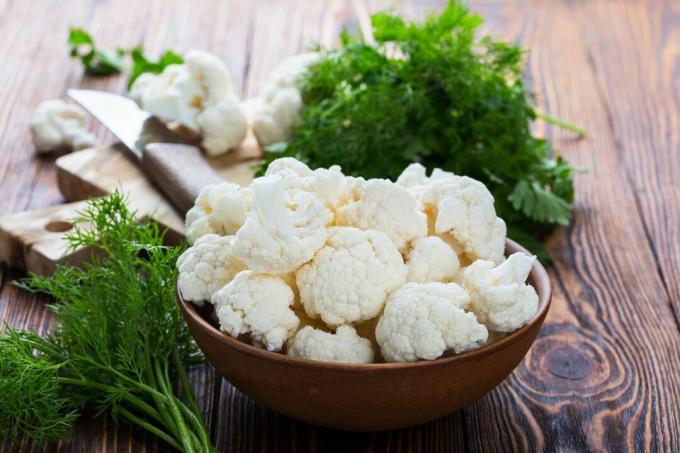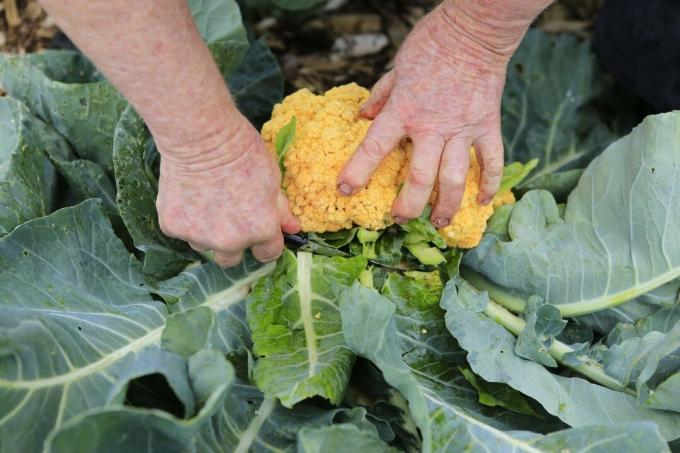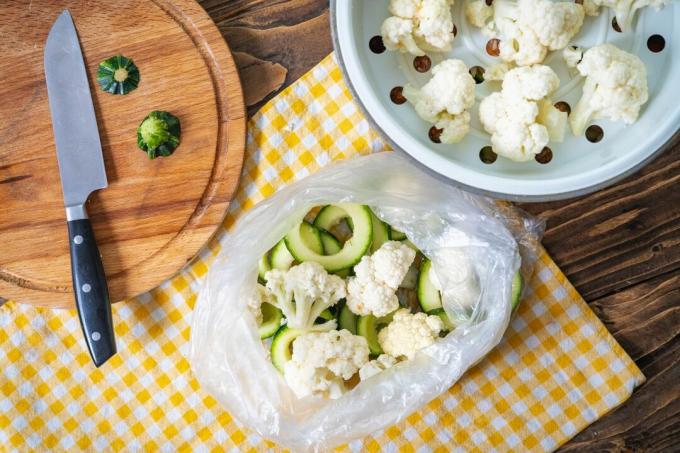After a rich cauliflower harvest, the cabbage must be properly stored. We show how to freeze cauliflower and make it durable.

After weeks of waiting and taking care of things, the time has finally come in summer: the first cauliflower heads can be harvested. The right harvest time is crucial here. Cauliflower ripens unevenly, which is not exactly a disadvantage: Depending on the variety and the weather, a single batch can be harvested for 1 to 6 weeks. Nevertheless, it can also happen that too much of the delicious cabbage ripens and has to be preserved at once. We'll tell you how you can store and keep cauliflower for as long as possible.
contents
-
Harvest cauliflower
- Harvest time for cauliflower
- Cut the cauliflower properly
-
Store and preserve cauliflower
- How long does cauliflower keep?
- Store cauliflower in the refrigerator
- Clean and wash the cauliflower
-
Preserving cauliflower
- Freeze cauliflower
- Blanch the cauliflower and reduce it
- Pickling cauliflower
Harvest cauliflower
Cauliflower rewards in summer and autumn with a rich harvest that needs to be brought in quickly. We give tips so that you can recognize the optimal harvest time and easily harvest the flower.
Harvest time for cauliflower
When your cauliflower is ready for harvest depends not only on the time of planting and the variety. The weather also has a huge influence on when the white florets are ready to harvest. Cauliflower, in particular, can be strongly influenced by temperatures that are too cool or too warm in early development, so that the harvest arrives early or late. It is wonderful that many cauliflower plants planted at the same time are usually ready for harvest in a time window of 1 - 6 weeks. Harvest the white "flowers" before they look fuzzy or discolored. They should be tight and closed. Early Cauliflower varieties can be harvested as early as mid-June, late varieties with a relatively late planting date until October.
Tip: Harvest your cauliflower for fresh consumption as needed, preferably early in the morning. Covered by its own leaves or a light fleece, it will stay on the stem for a few weeks longer.
Cut the cauliflower properly
You don't need a lot of equipment to harvest cauliflower. Always cut your cauliflower with a sharp knife so that the injuries to the cabbage are minimal. It stays fresh longer and loses less moisture. The crop cut should be placed well below the stem base. Immediately after the early morning harvest, the flower should be cooled down with ice-cold water.

Note: If you leave the bracts on the cauliflower head, it will stay fresh longer.
Store and preserve cauliflower
Storing the delicate cabbage vegetables is not easy. We therefore give tips so that you can enjoy harvested cauliflower for as long as possible.
How long does cauliflower keep?
Cauliflower gives, just like broccoli (Brassica oleracea var. italica) quickly removes a lot of water after the harvest and acquires a withered, rubbery consistency. Depending on how it is stored, cauliflower can be kept fresh for up to six weeks. Cauliflower reacts very sensitively to the ripening gas ethylene, which some types of fruit and vegetables emit in the course of post-ripening. The gas stimulates the cells of the cauliflower to become active, causing it to wither and spoil faster. Cauliflower should therefore never be stored next to fruit or other fruits such as tomatoes.
Store cauliflower in the refrigerator
Cauliflower can be stored in the refrigerator for a while. If it is freshly harvested, still leafed and stored unwashed, it can be kept for up to 14 days at 0 to 4 ° C. At 0 ° C throughout and in the dark, isolated from other types of vegetables, a young-harvested cauliflower can even last up to 6 weeks.
Note: When cooked, the cauliflower spoils in the refrigerator within a very short time and should ideally be consumed the next day.
Clean and wash the cauliflower
With its bulging florets, the cauliflower offers a lot of attack surface for dirt and dust. It is therefore important to clean it thoroughly before consuming it or processing it further. First remove the leaves and separate the individual florets from the main stem. Remove brown discolored and damaged florets when cleaning the cauliflower. Then wash the cauliflower florets under running water and drain them in a colander.

Preserving cauliflower
The tasty inflorescences of cauliflower can also be preserved for a long time. We explain which methods work best.
Freeze cauliflower
The cauliflower can be frozen without blanching and still raw. This is what distinguishes the white vitamin wonder from some of its kind, such as the one Kale (Brassica oleracea var. sabellica). Before freezing, cut the individual florets from the cauliflower head, wash them and drain them in a colander. Then portion the washed cauliflower and put it in the freezer.
Blanch the cauliflower and reduce it
To make cauliflower more digestible, it is often blanched. This is also the first step in boiling or pickling the inflorescences. For blanching, put the cut cauliflower florets in boiling salted water for a few minutes, until they are just a bit firm to the bite. A strong dash of citric acid in the water can help keep the cabbage white in color. The florets can now be poured off and should be rinsed off with cool water.
To boil five cauliflower heads in glasses, take two liters of boiling salted water and put florets and brine in glasses. Only screw the lids loosely on the jars, because air must be able to escape during the boiling process. The glasses are now boiled at 100 ° C for at least 20 minutes. This can be done, for example, in a tall, water-filled casserole dish in the oven or by placing the glasses in a large, water-filled saucepan. After boiling, screw the lid on tightly, turn the jars upside down and let them cool down.
Pickling cauliflower
Like almost every vegetable, cauliflower can also be fermented, i.e. pickled. To do this, you should cut and wash the raw cauliflower. Then a 2-4% brine is made by dissolving 20 to 40 grams of pure salt in water. The cauliflower florets are then layered in the glass as tightly as possible, leaving only 3 to 4 cm of space under the edge. A fermentation weight is placed on top of the cauliflower and finally the brine is poured into it. The fermentation weight should be completely covered with brine. The jar is now tightly closed and placed at room temperature for 5 - 7 days - this is how the fermentation starts. After another 2 - 3 weeks of gentle fermentation in the refrigerator or in the cool cellar, the pickled one is ready Cauliflower ready to eat and will keep for a few more months - especially if the edge of the glass is kept clean will.

Before you can preserve cauliflower, it is important to ensure that it is harvested. Cauliflower can be visited by all sorts of pests during cultivation. Are particularly common Cabbage white butterfly and its insatiable caterpillars. We introduce the butterfly species and give tips on how to combat it.



